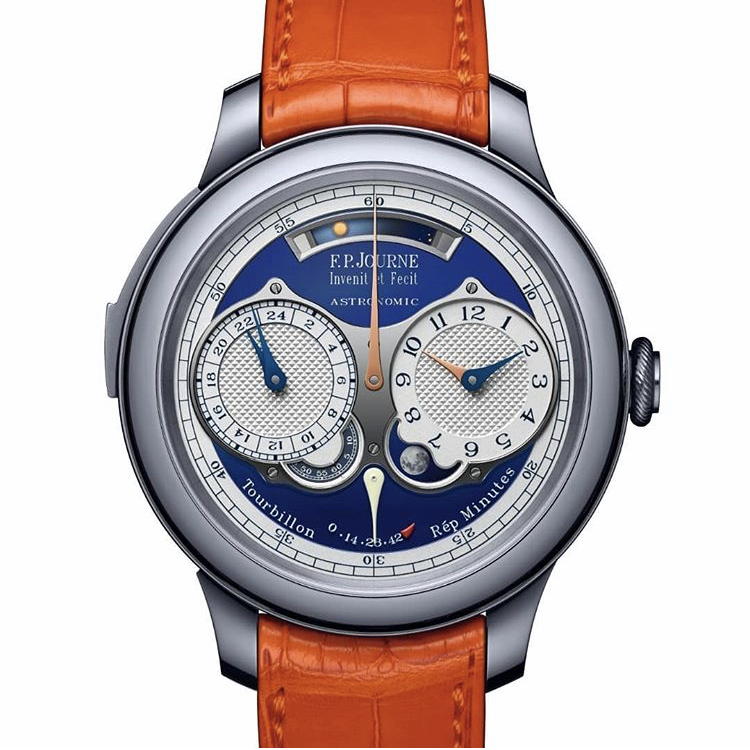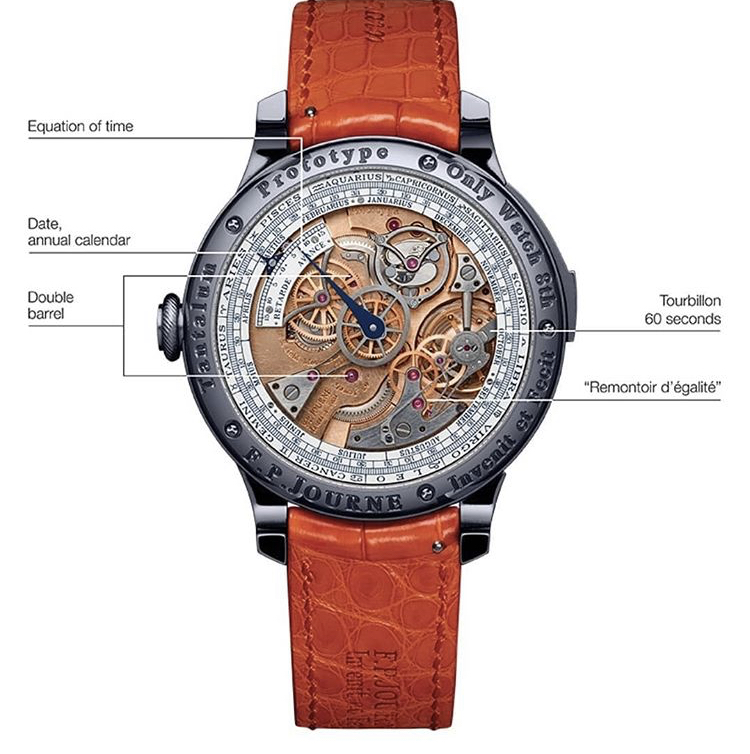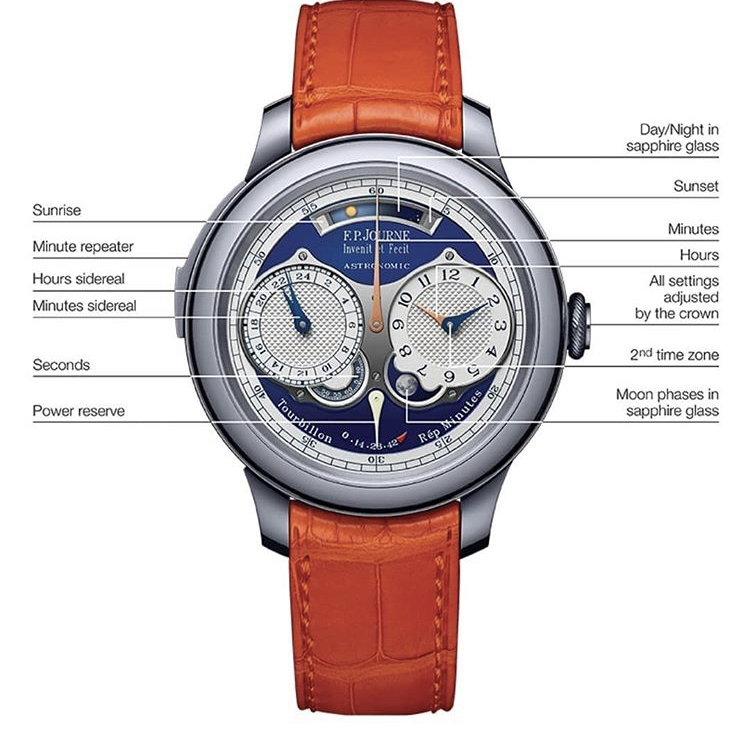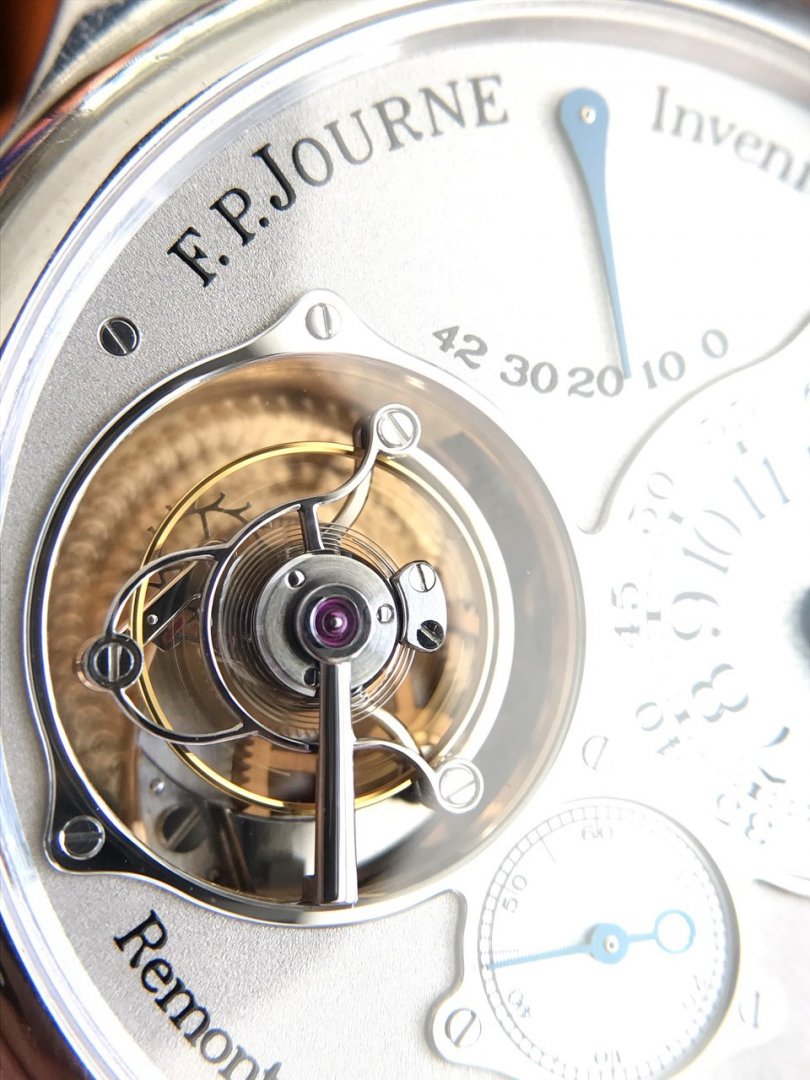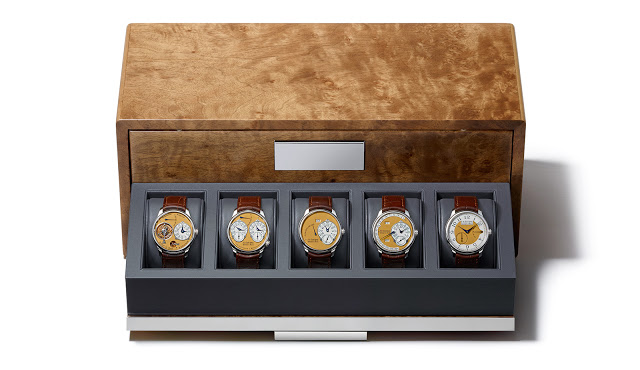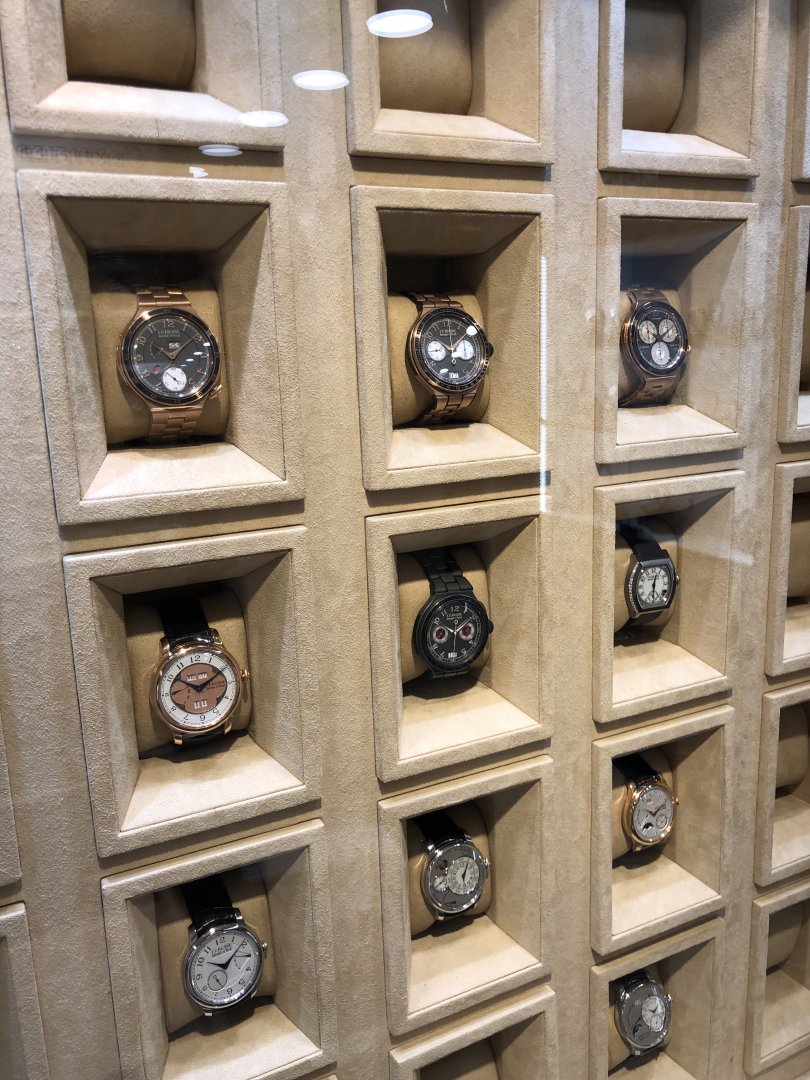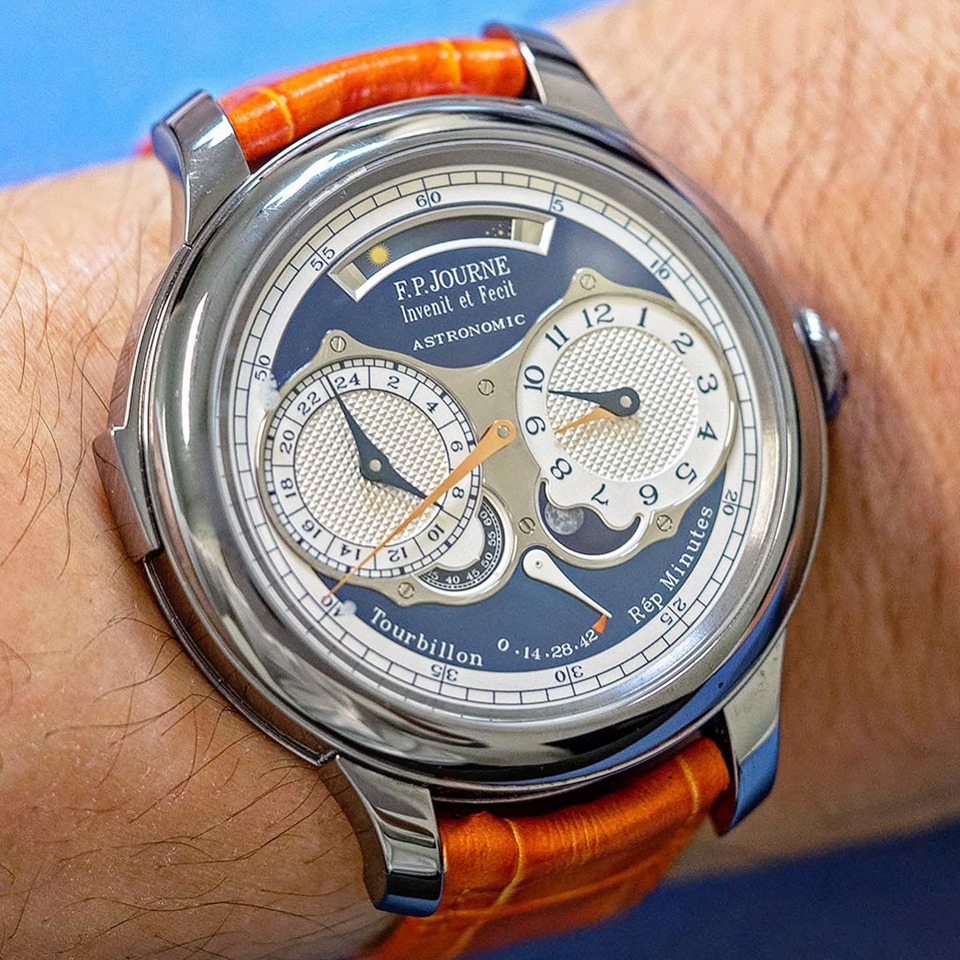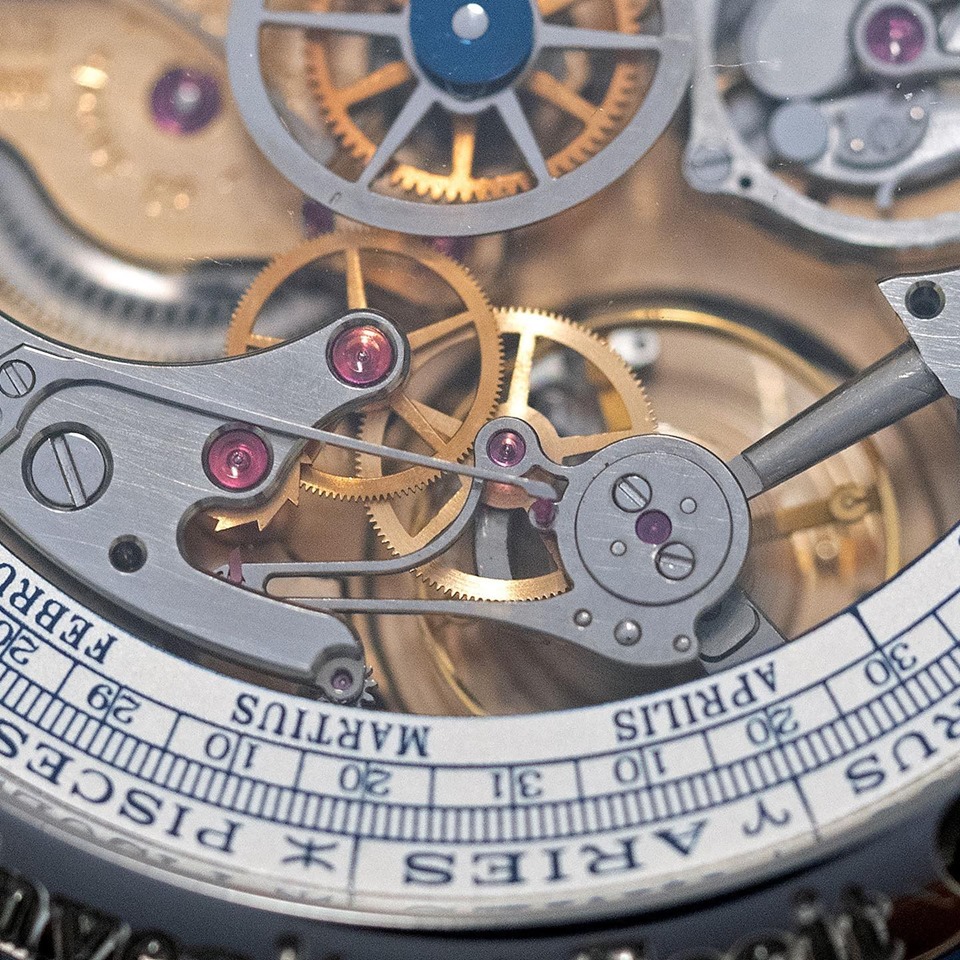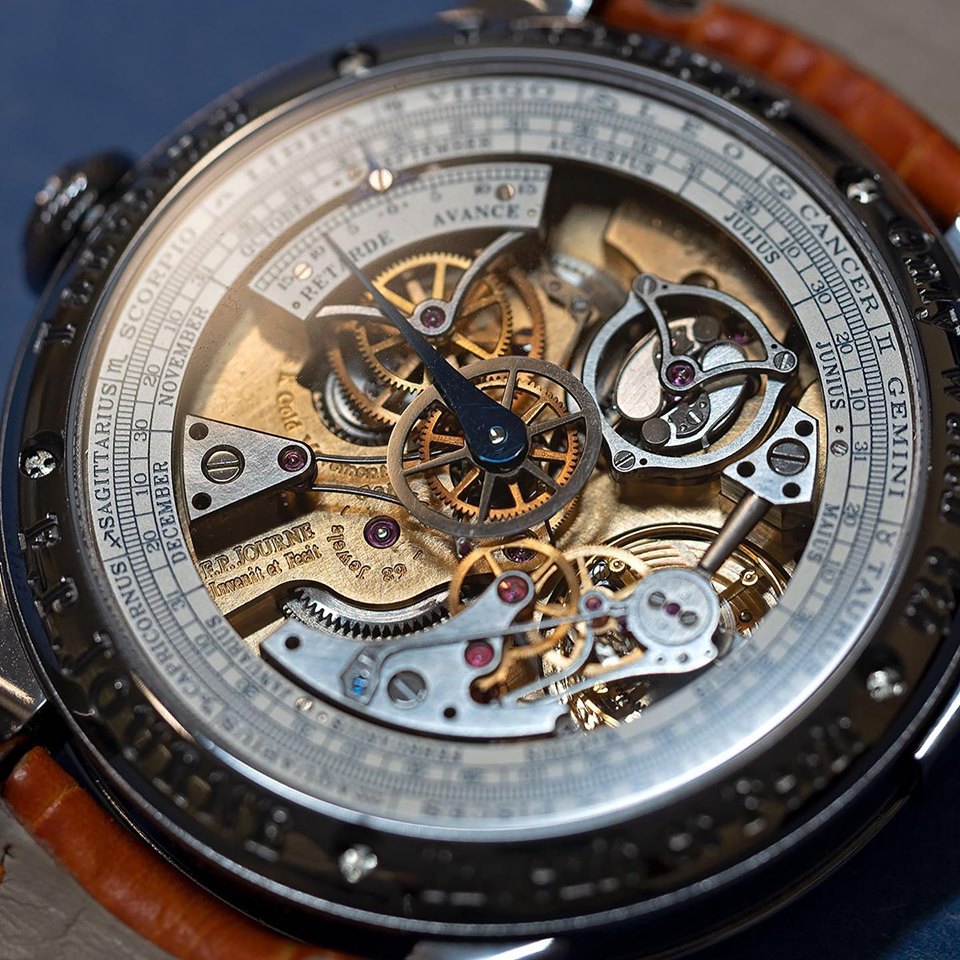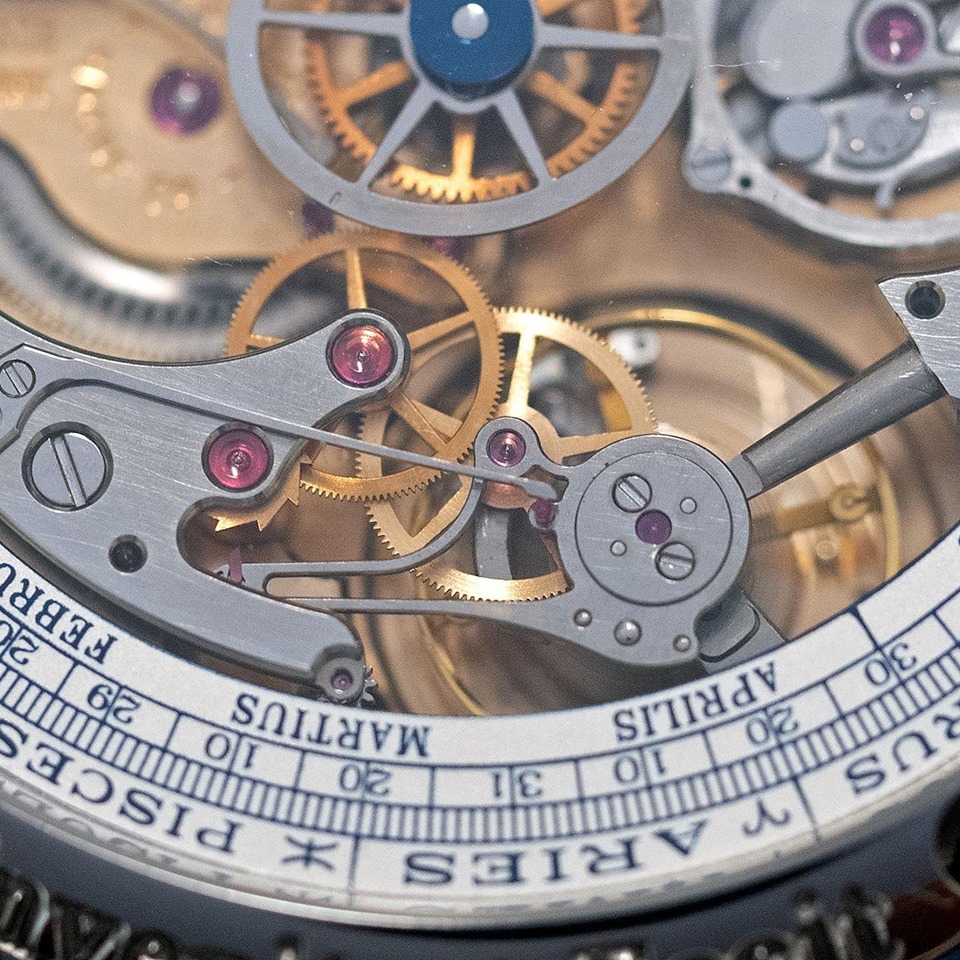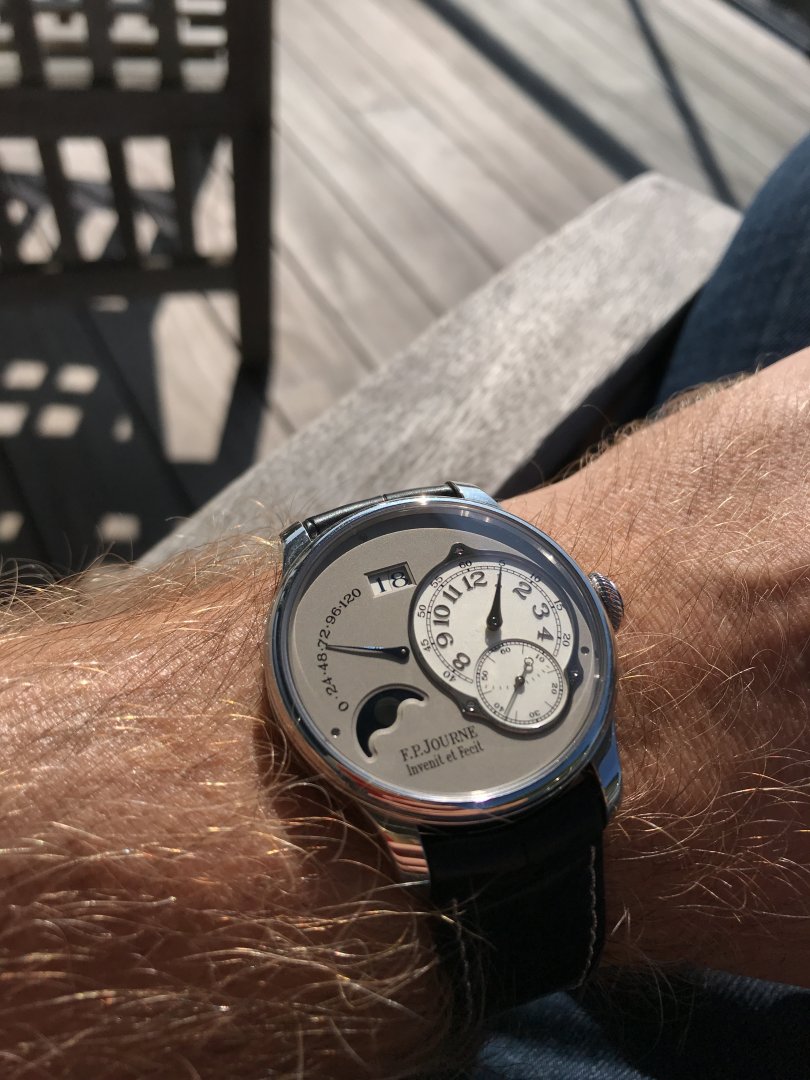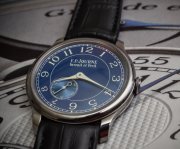F.P.Journe-tråden
- Trådstarter Havvo
- Opprettet
Du bruker en utdatert nettleser. Det kan ikke vise dette eller andre nettsteder på riktig måte.
Du bør oppgradere eller bruke en alternativ nettleser.
Du bør oppgradere eller bruke en alternativ nettleser.
Tuesday Cocktails at the Geneva Boutique
in FP JOURNE on JUNE 27, 2019 SHARE
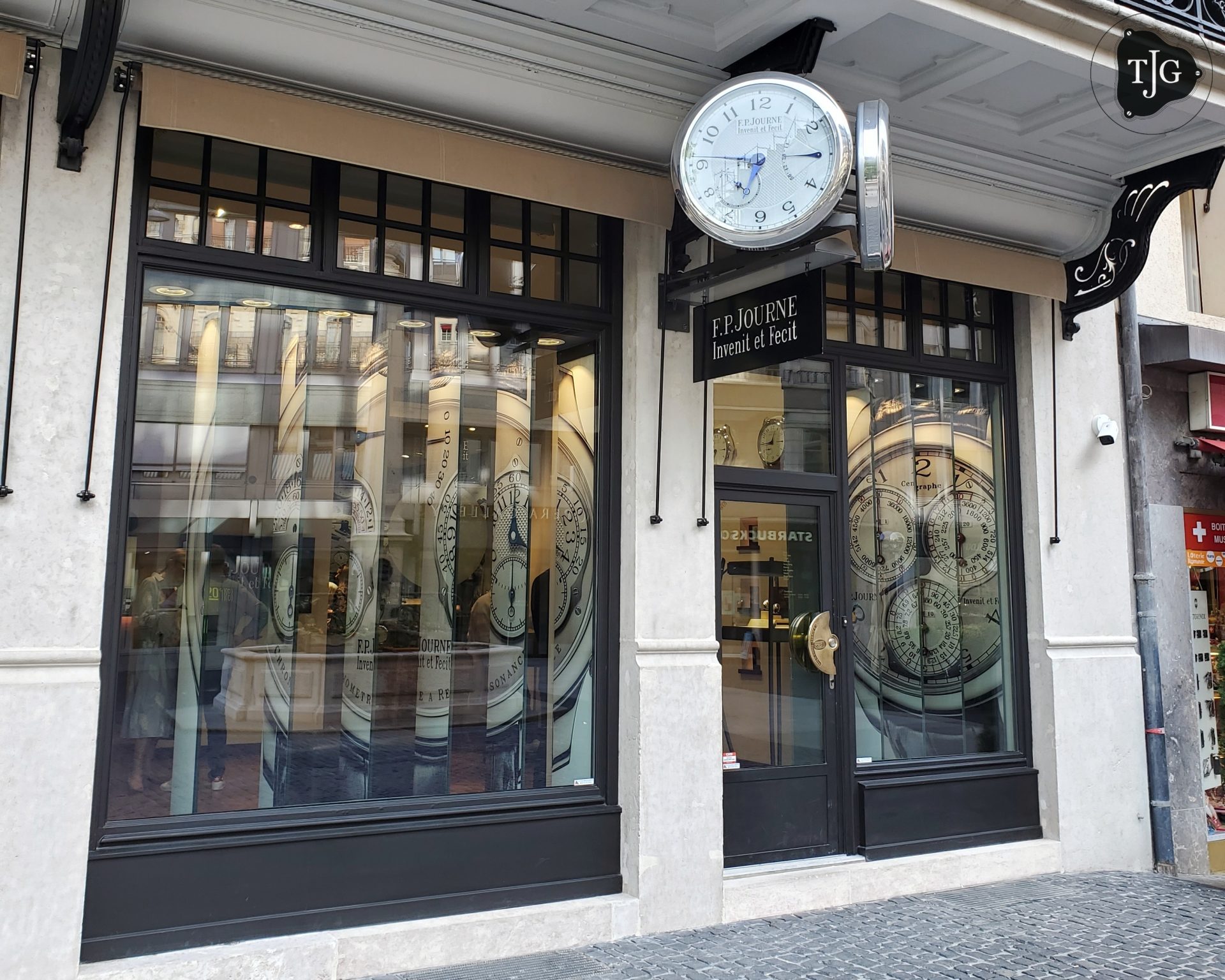
Earlier this month I was spending the week in Geneva and to my chance, attend the first launch of F.P. Journe’s monthly Tuesday Cocktails.
For those who might’ve missed it, the official announcement had been released just a few days prior through the brand’s Instagram account here. The idea is that each wholly owned boutique hosts a little cocktail hour at the first Tuesday of each month and watch lovers could come and meet other watch enthusiasts for some cocktails.
While the idea isn’t necessarily original with all the various watch clubs around the world and many brands who host several different events every now and then; this is the first time a brand takes the invitation one step further in being all-inclusive. It is by no means an ‘exclusive’ invitation sent to specific people but a much broader invite to “All lovers of horology worldwide,” as the brand put it.
My Experience
The Geneva Boutique had been closed for renovations for well over a year and this first event happened to not only mark the start of the Cocktail Hours, but the reopening of the Boutique itself.
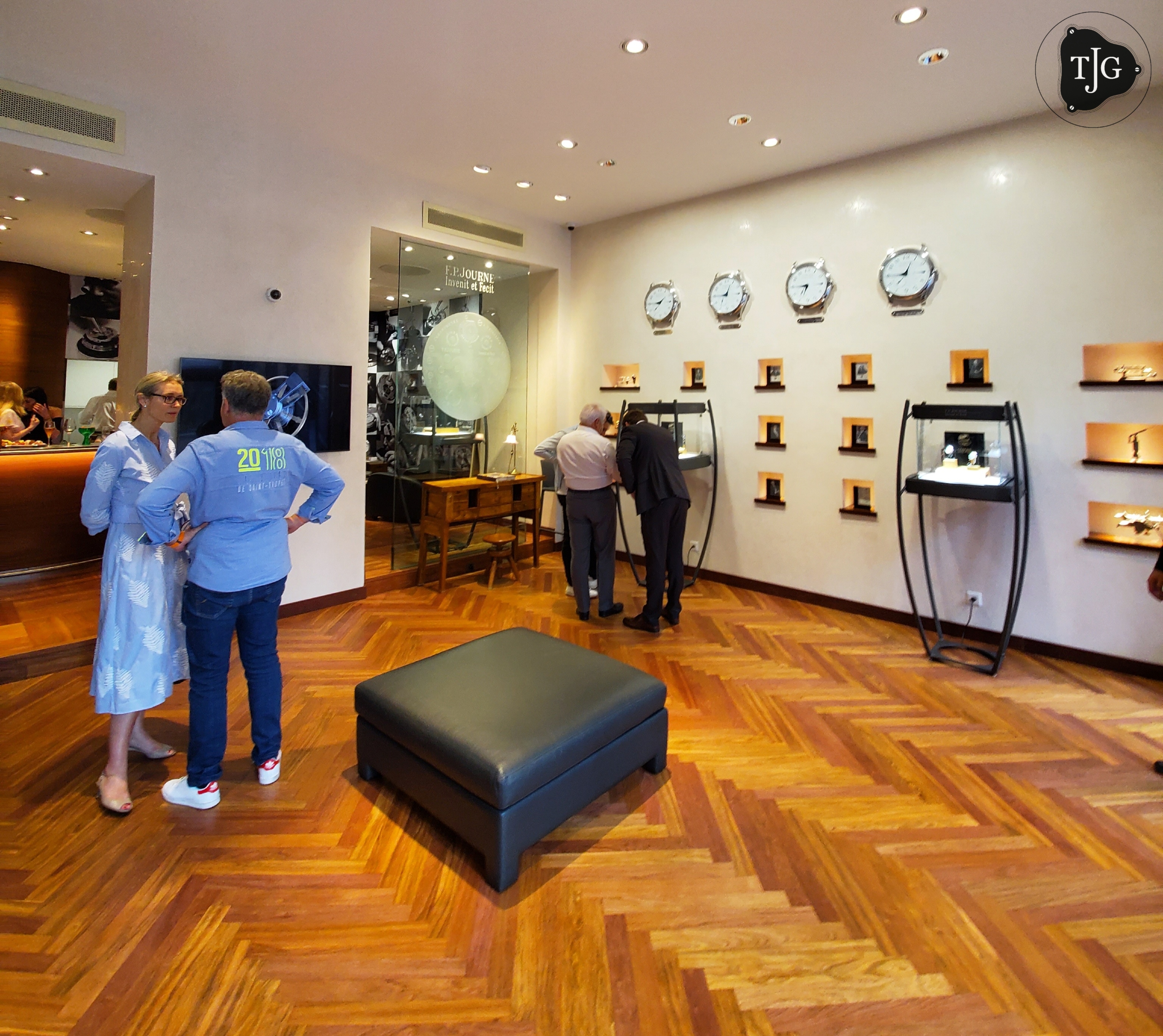
Inside, the boutique follows the same original concept with the watches displayed at the front end of the store with the seating and bar towards the back. Overall, it’s not a complete departure from what it used to be, though a tad smaller than what it used to be.
I arrived an hour or so into the event and noticed guests were mostly local (I think). Overall, the vibe was as it always is with any F.P. Journe event, very relaxed. People came and left as they pleased; some stopping by for a quick greeting and some quite literally had no idea what was happening and just entered the store in their shorts and flip flops cause they noticed the Boutique lights were on.
The Watches
Typical of a Journe event, I was quite the watch spotter and noticed some fancy pieces that I was fortunate enough to remember to take pictures of:
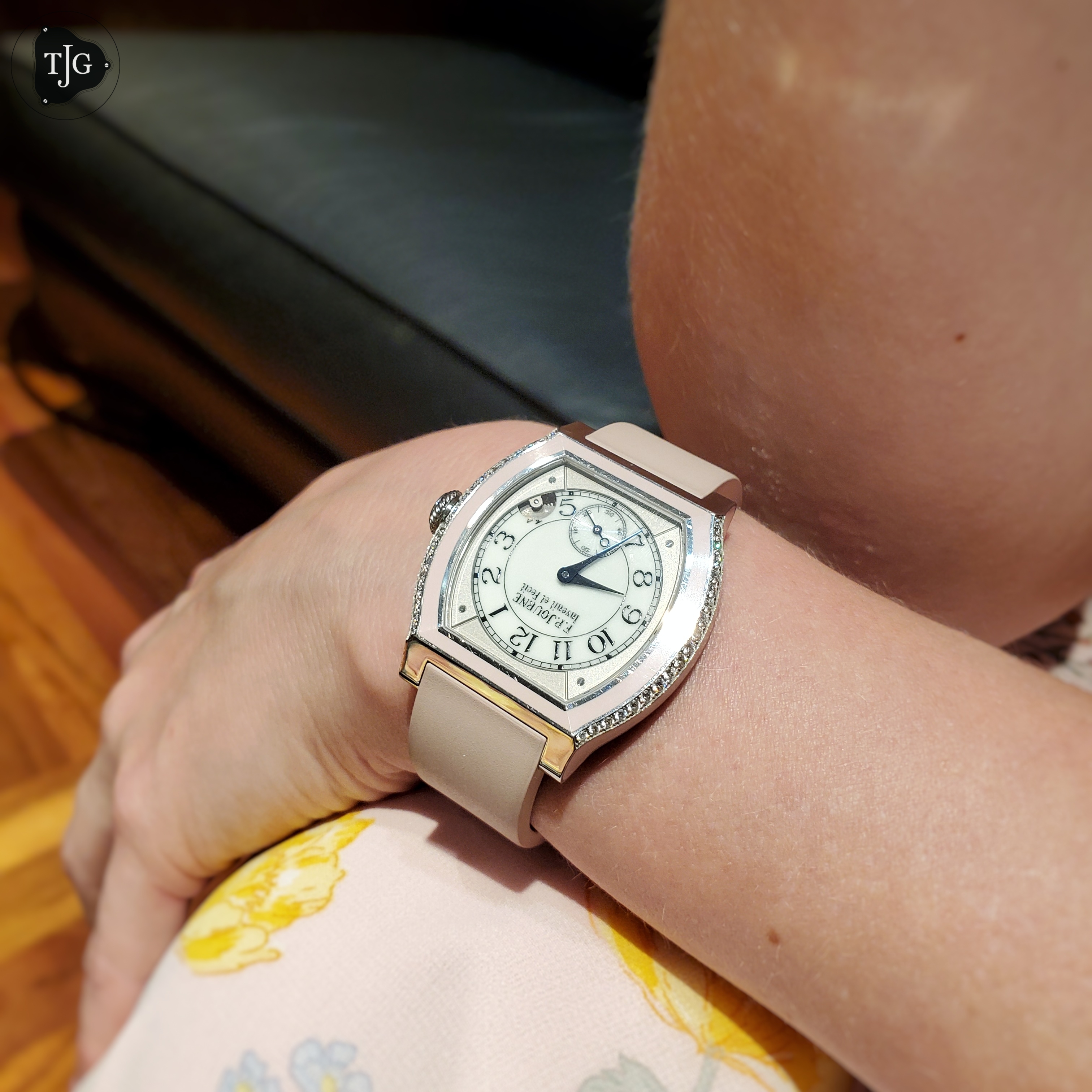
A pink élégante with a single row of diamonds.
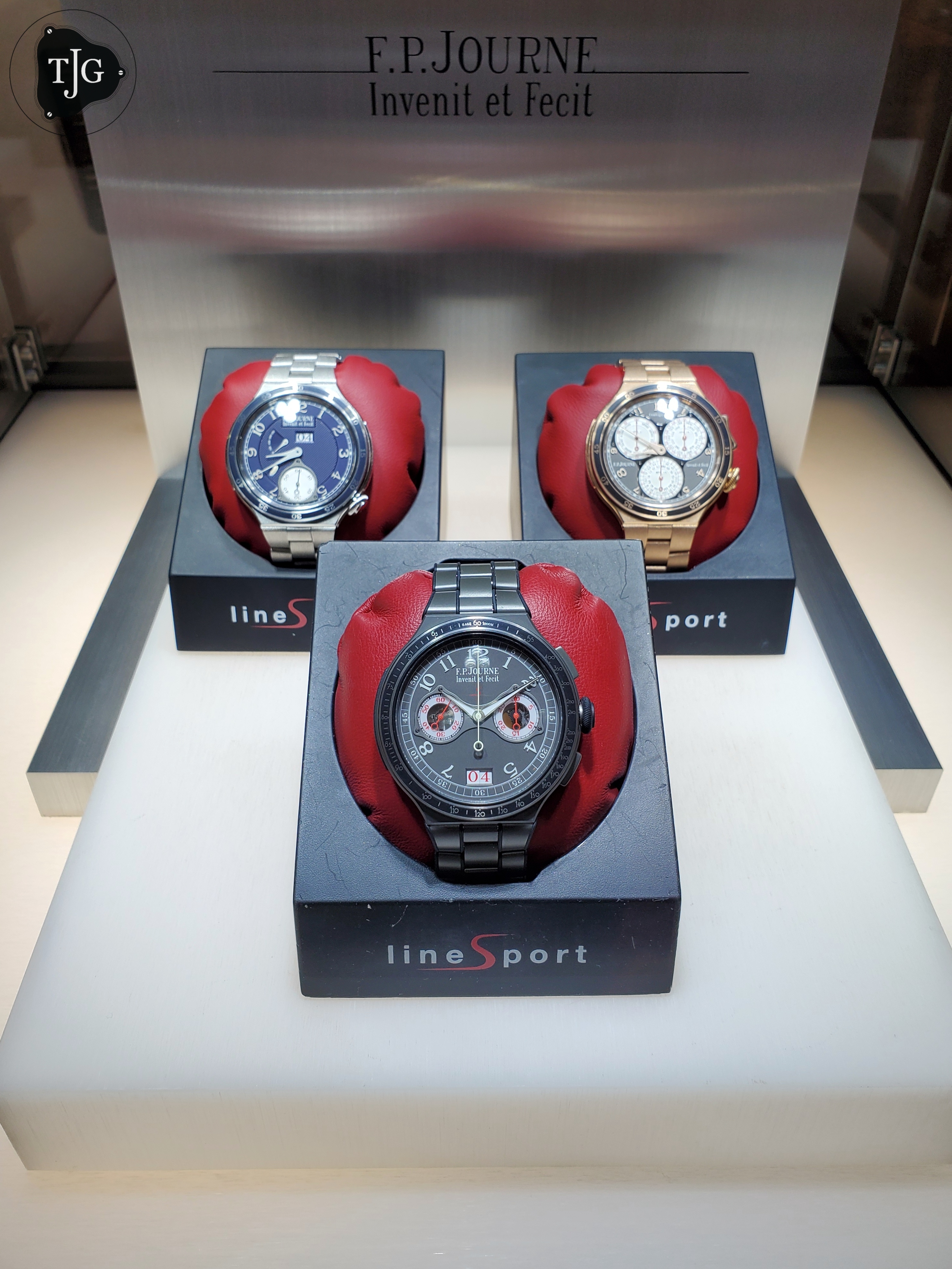
The LineSport: Octa AR2 in platinum; Centigraphe 2 in rose gold and front is the CMS in titanium.
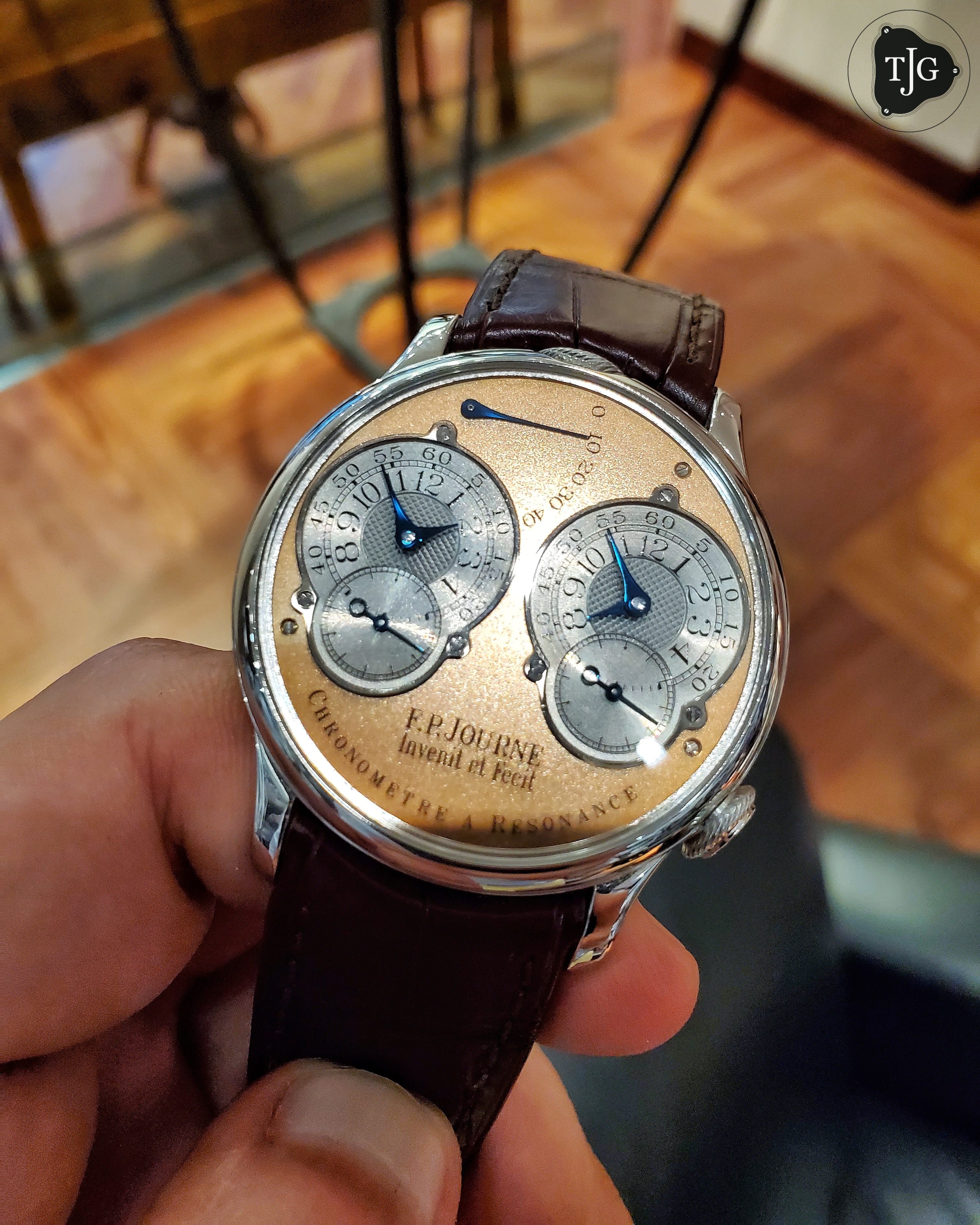
One of the earliest Resonance the Manufacture ever produced.
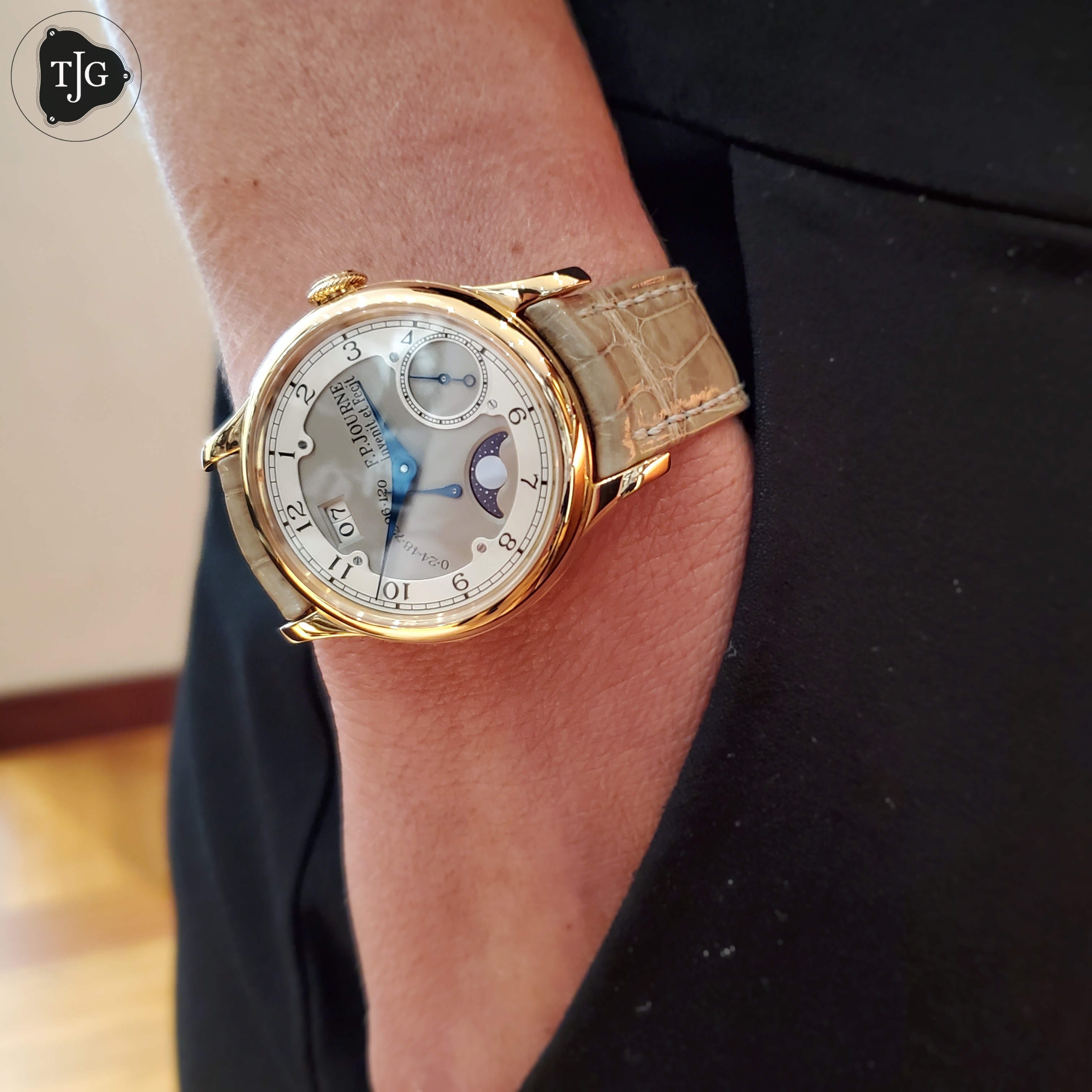
My personal favorite and so elegantly worn, a 36mm Octa Divine.
In Mr. Journe’s Words
I don’t typically share articles that cover certain events but the main reason I wanted to share this particular experience was because of what I overheard François-Paul Journe say to one of his clients/friends. He was asked about his thoughts regarding the Cocktail Hours and what he thought of the evening thus far; I will do my best to write it word-for-word as I think it really reflects the whole point of this and where Journe stands in regards to passionate enthusiasts.
“I’m not interested to know if everyone who shows up is an F.P. Journe client or not because that’s not why I am doing this. I am doing this for EVERYONE who loves horology. This is a place for people who love watches and watchmaking, and they can come every month and meet others who share the same passion, and do it in the presence of watchmaking.
It’s great because we have boutiques across the world and every few hours I will get a picture of the same event, at the same time, in another place across the world. I’ve already seen the events in Asia and now I will get the pictures from the US market and that’s fun for me to see. It’s about giving service to watch lovers around the world and not just to people who buy my watches.”
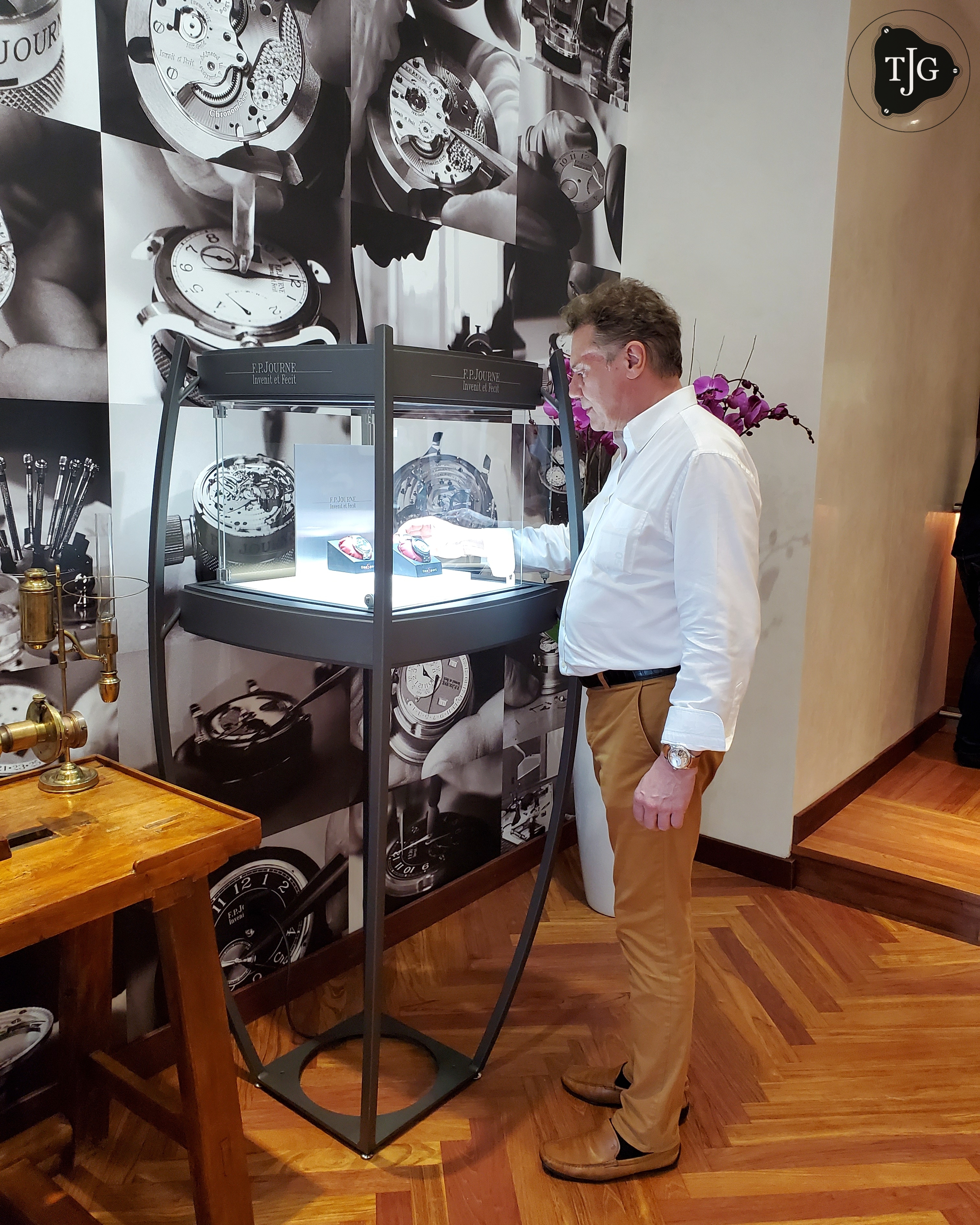
François-Paul Journe at the Tuesday Cocktail Hours in Geneva
in FP JOURNE on JUNE 27, 2019 SHARE

Earlier this month I was spending the week in Geneva and to my chance, attend the first launch of F.P. Journe’s monthly Tuesday Cocktails.
For those who might’ve missed it, the official announcement had been released just a few days prior through the brand’s Instagram account here. The idea is that each wholly owned boutique hosts a little cocktail hour at the first Tuesday of each month and watch lovers could come and meet other watch enthusiasts for some cocktails.
While the idea isn’t necessarily original with all the various watch clubs around the world and many brands who host several different events every now and then; this is the first time a brand takes the invitation one step further in being all-inclusive. It is by no means an ‘exclusive’ invitation sent to specific people but a much broader invite to “All lovers of horology worldwide,” as the brand put it.
My Experience
The Geneva Boutique had been closed for renovations for well over a year and this first event happened to not only mark the start of the Cocktail Hours, but the reopening of the Boutique itself.

Inside, the boutique follows the same original concept with the watches displayed at the front end of the store with the seating and bar towards the back. Overall, it’s not a complete departure from what it used to be, though a tad smaller than what it used to be.
I arrived an hour or so into the event and noticed guests were mostly local (I think). Overall, the vibe was as it always is with any F.P. Journe event, very relaxed. People came and left as they pleased; some stopping by for a quick greeting and some quite literally had no idea what was happening and just entered the store in their shorts and flip flops cause they noticed the Boutique lights were on.
The Watches
Typical of a Journe event, I was quite the watch spotter and noticed some fancy pieces that I was fortunate enough to remember to take pictures of:

A pink élégante with a single row of diamonds.

The LineSport: Octa AR2 in platinum; Centigraphe 2 in rose gold and front is the CMS in titanium.

One of the earliest Resonance the Manufacture ever produced.

My personal favorite and so elegantly worn, a 36mm Octa Divine.
In Mr. Journe’s Words
I don’t typically share articles that cover certain events but the main reason I wanted to share this particular experience was because of what I overheard François-Paul Journe say to one of his clients/friends. He was asked about his thoughts regarding the Cocktail Hours and what he thought of the evening thus far; I will do my best to write it word-for-word as I think it really reflects the whole point of this and where Journe stands in regards to passionate enthusiasts.
“I’m not interested to know if everyone who shows up is an F.P. Journe client or not because that’s not why I am doing this. I am doing this for EVERYONE who loves horology. This is a place for people who love watches and watchmaking, and they can come every month and meet others who share the same passion, and do it in the presence of watchmaking.
It’s great because we have boutiques across the world and every few hours I will get a picture of the same event, at the same time, in another place across the world. I’ve already seen the events in Asia and now I will get the pictures from the US market and that’s fun for me to see. It’s about giving service to watch lovers around the world and not just to people who buy my watches.”

François-Paul Journe at the Tuesday Cocktail Hours in Geneva
Behind The Lens: The F.P. Journe Tourbillon Souverain – Reprise
by GaryG
One of the great advantages of belonging to the relatively close-knit community of watch collectors is that one has the opportunity to see a lot of great watches.
Even the small group of enthusiasts that I hang out with on a regular basis collectively owns a significant assortment of some of the greatest watches I know – and as they are generous fellows, I have fairly regular opportunities to see, try on, and photograph some of these fantastic pieces.
That’s great for me because like many watch enthusiasts, I’ve also gone a bit nuts about photography. Specifically, macro photography, which at my relatively modest level of competence provides an opportunity to hunch over a camera and light tent for hours on end, fiddling with camera, lens, and watches, hoping that at least a few of the resulting images will justify the stiff neck and strained eyes.
There is now a payoff, though: from time to time, as part of my “enthusiast collector” role here at Quill & Pad I will be taking a look at watches that strike my fancy, and sharing the visual results with you along with a few observations on photography, the watches themselves, and the collectors who own them.
Let’s get started, shall we? Our subject for this episode: the F.P. Journe Tourbillon Souverain with remontoir d’égalité.
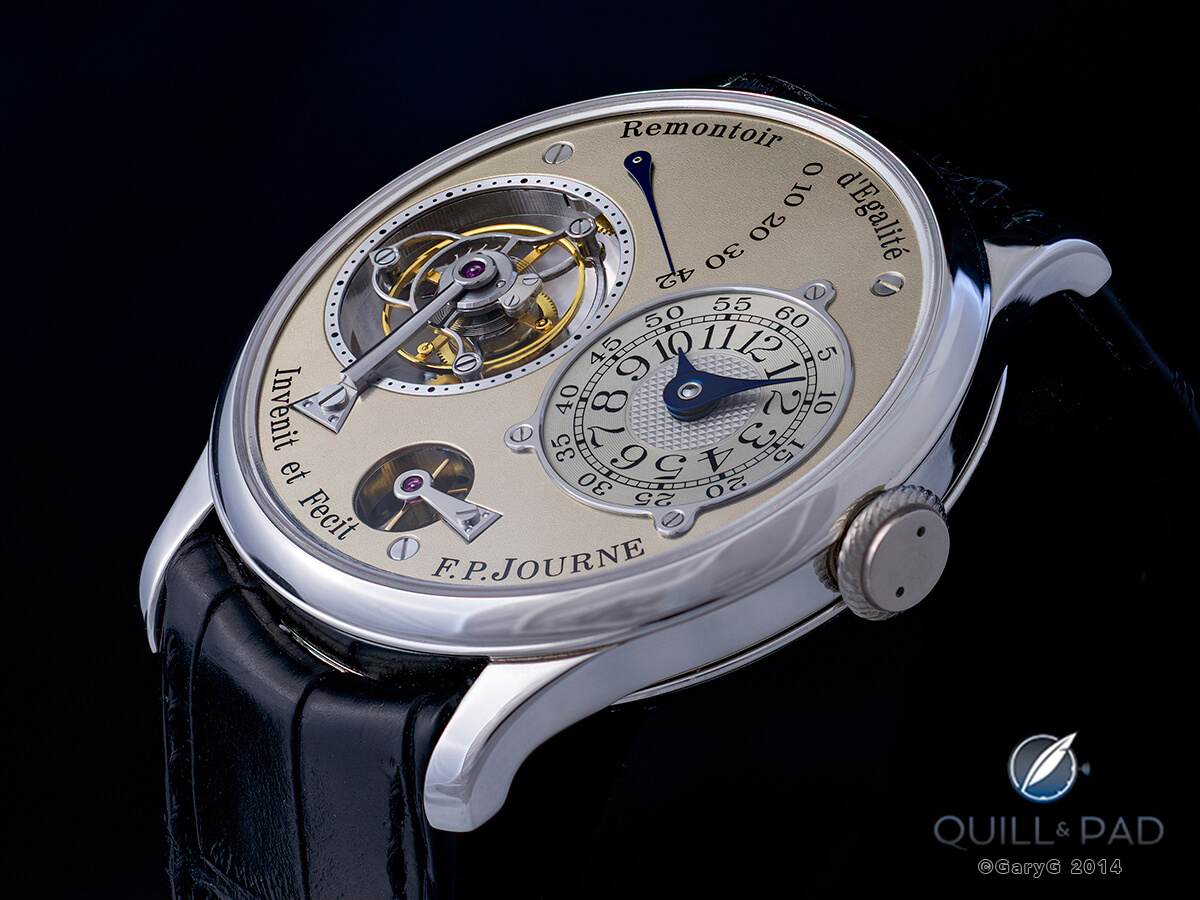
F.P. Journe Tourbillon Souverain with remontoir d’égalité
My photography mentor, the outrageously talented Ming Thein, sets out four elements required for a good image: light, subject, composition, and story.
Regardless of what you think of the lighting and composition of this first shot, I hope that you will agree that the subject is a doozy! The Tourbillon Souverain was the first model sold by Mr. Journe’s eponymous enterprise, F.P Journe. In addition to its technical sophistication, it set the basis for the visual style and design cues that are characteristic of Journe’s watches to this day.
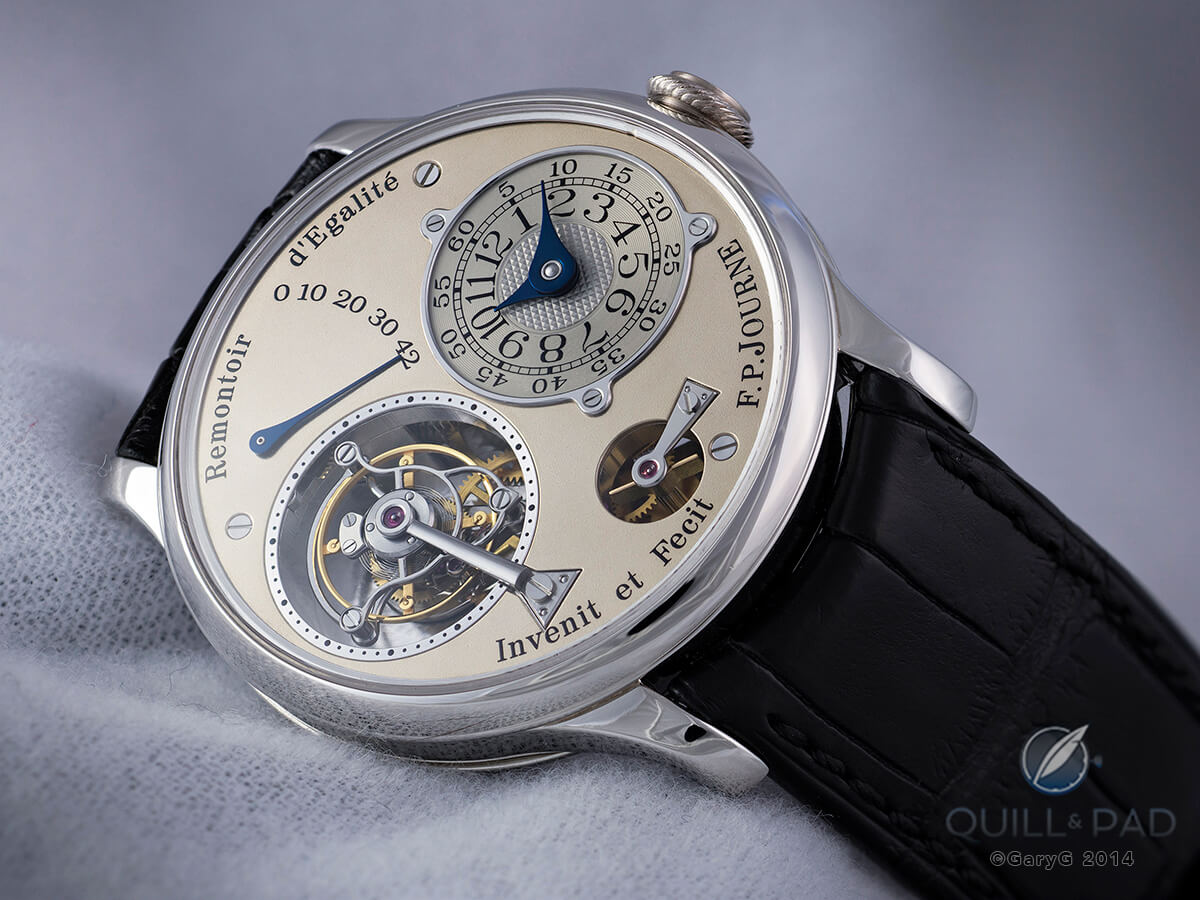
F.P. Journe Tourbillon Souverain with remontoir d’égalité
Many directly noticeable visual elements tell us that this is a Journe watch well before we see his name or read the Invenit et Fecit motto on the dial.
These include the use of silvered subdials with screw-mounted steel frames; the fonts; the ornate appearance of the main subdial with its explicit labeling of hours and minutes, railroad track, and guilloche center; the shapes of the hands and bridges; and even the characteristic crown with its rope edge motif.
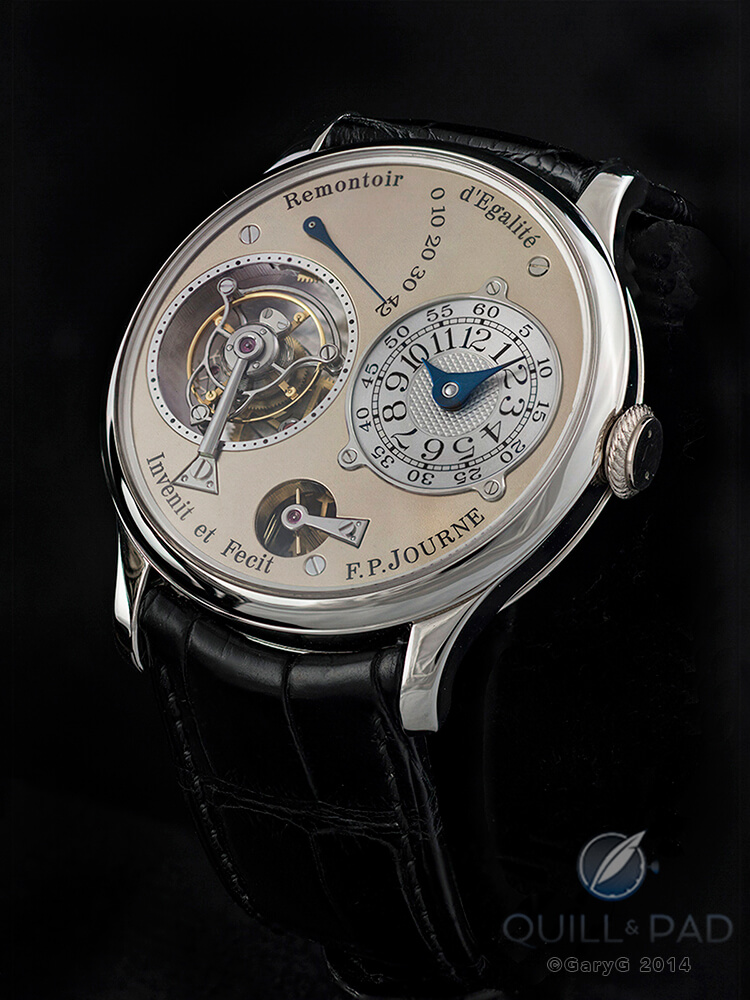
F.P. Journe Tourbillon Souverain with remontoir d’égalité
There is an inherent risk to getting into watch photography as a watch enthusiast: mixing the two hobbies puts you at a serious peril of buying watches when you weren’t planning to do so! In this instance, a friend of mine asked whether I would take a few pictures of his Journe tourbillon so that he could post the watch for sale.
I happily took him up on his offer, but then something entirely predictable happened: I could not put this one down. He did (or didn’t, depending on your point of view) help by encouraging me to “feel free to keep it and wear it around for a while.”
Suffice it to say that one thing led to another, and now this piece occupies a place of pride in my own collection. Perhaps I’ll return to this watch here on Quill & Pad at some later time and provide a full review that sets out all of its virtues as I see them.
But for now, I’ll just call your attention to the white gold dial and its beautiful color. These early white gold dials from Journe have a tone I haven’t seen anywhere else – almost a champagne color – that I could stare at for hours and that, for me, is the ideal complement to the crisper appearance of the platinum case.
If this watch is so great, you ask, why in the world was my pal selling his? As it turns out, he had just bought the one shown below.
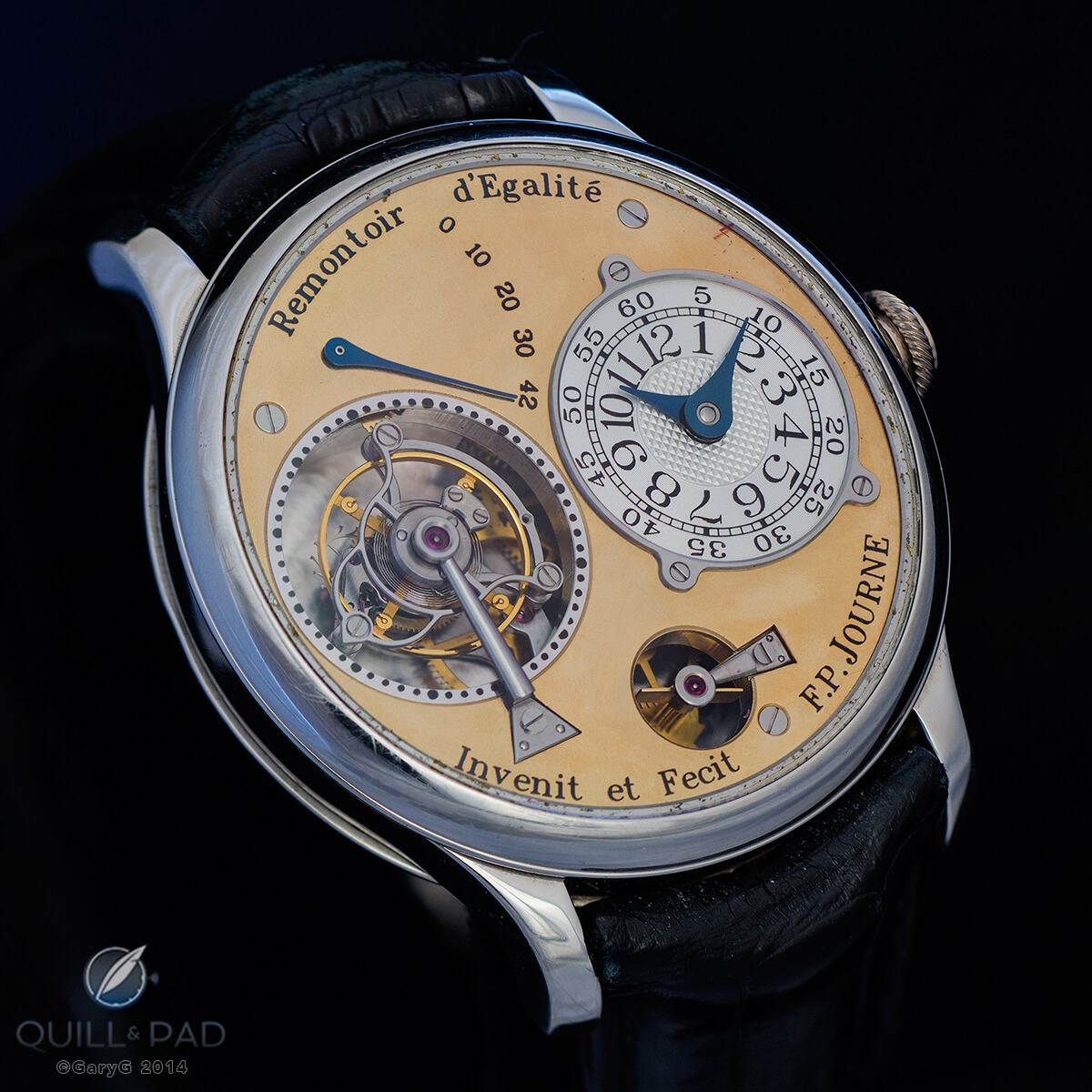
Early model F.P. Journe Tourbillon Souverain with remontoir d’égalité
Wait a minute – isn’t that the same watch? Well, yes and no! Of course, it is also an early Tourbillon Souverain, in fact, even earlier in the series than mine. The most obvious difference is the yellow gold dial, and not just any yellow, but a striking, deep yellow that is to many an even more appealing hue than my “champagne” dial.
It is a dial greatly prized by Journe collectors. Due to the reflectivity of the dial, it’s very difficult to capture its true essence – but perhaps this next shot will give you a sense.
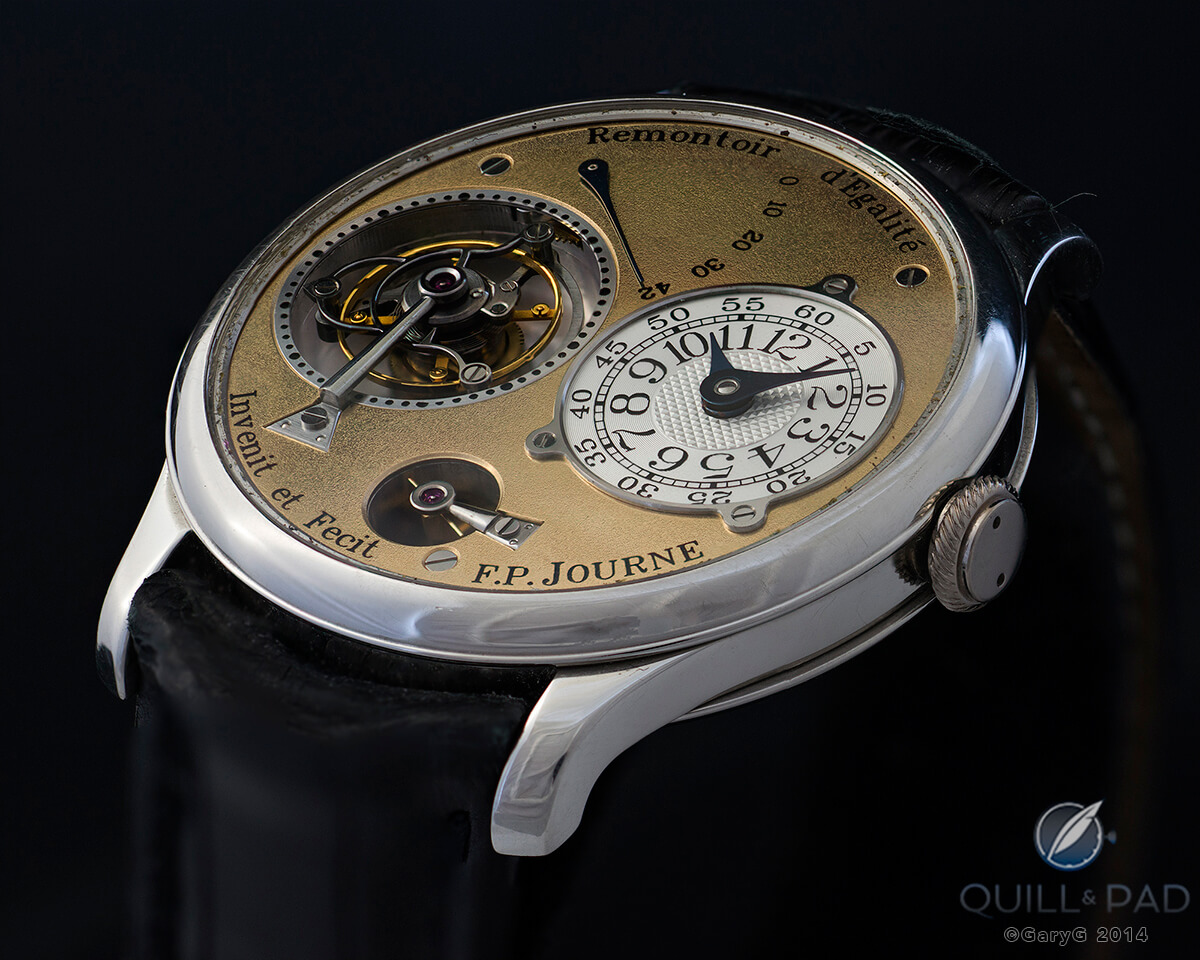
Early model F.P. Journe Tourbillon Souverain with remontoir d’égalité
Despite the apparent similarity of the two watches, there are also several other subtle differences between them that enthusiasts discuss and debate. Take a look at the side-by-side image below and see how many you can spot.
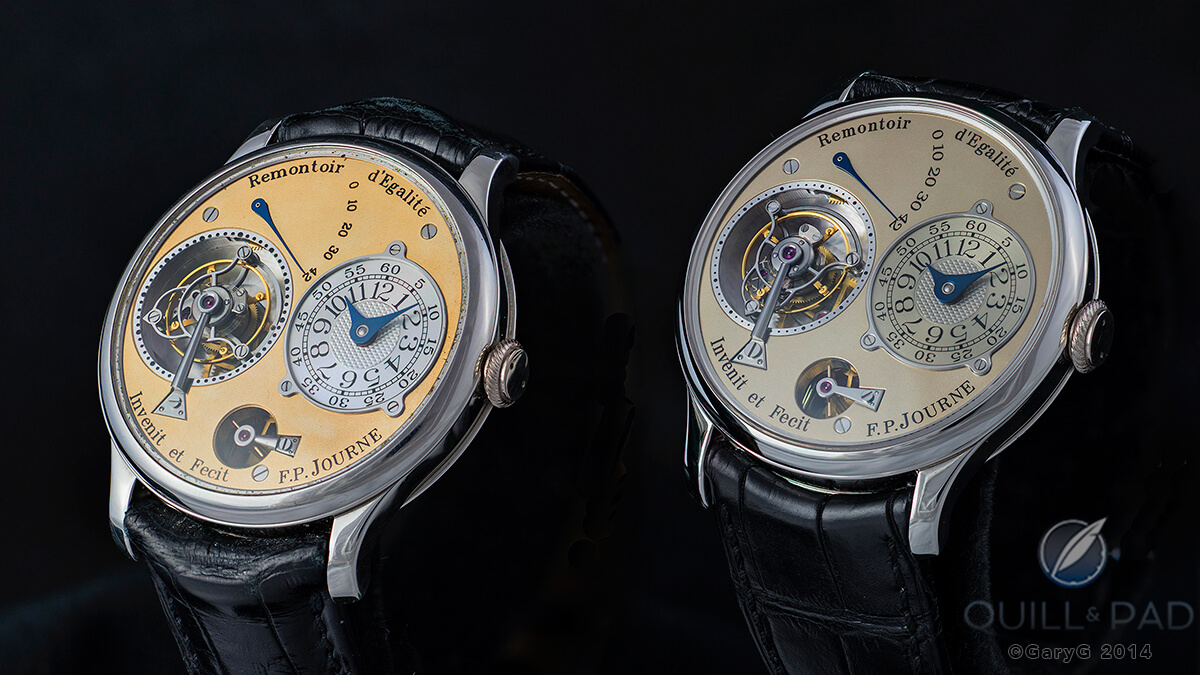
Two F.P. Journe Tourbillon Souverain models with remontoir d’égalité; the slightly earlier model is at left
I may actually miss one or two myself, but based on both research and personal observation, I’d say that in comparison to my watch, the yellow-dialed one is different in the following ways:
The word “Remontoir” is slightly closer to 12 o’clock. Also, the font of the term “Remontoir d’Egalité” also appears to be very slightly different than that on the white gold-dialed watch. Among other things, if you look very carefully you can see that the apostrophe is curved on my friend’s watch and straight on mine.
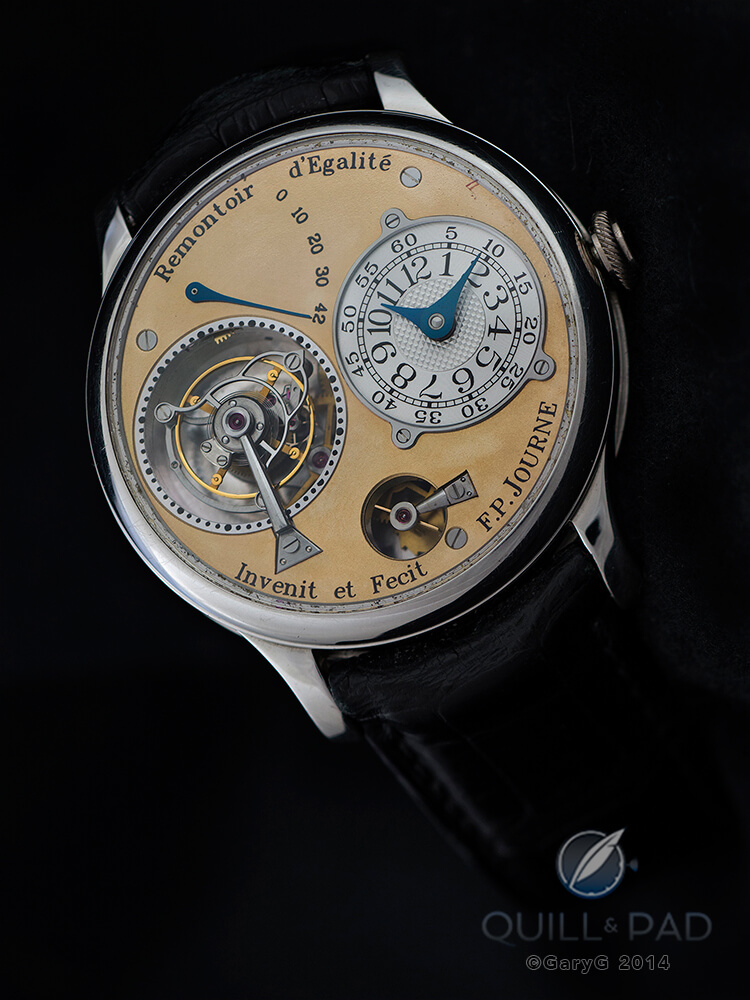
Early model F.P. Journe Tourbillon Souverain with remontoir d’égalité
If you’ve been looking at the photos carefully – and if you’ve gotten this far I am guessing that you have – you have already learned one important fact about watch photography: the macro lens (especially when coupled with a high-resolution camera like my Nikon D800E) is a harsh mistress.
Woe be unto her or him who prior to shooting does not invest the time needed to clean the watch thoroughly, as each speck of dust will look like a boulder and any stray threads seem to take on the size of those ropes they use to tie up ocean liners.
As we look at my buddy’s new pride and joy, we can clearly see that it is in need of a full service – lots of crumbled adhesive inside the crystal around its edge (and even some sort of red thread that has worked its way in there), dirty, spent oils on many of the steel surfaces, pitting on the hands, uneven patina on the main dial, scratches on the case, and so on.
Happily, as my “new” watch shows, Journe does a great job reconditioning watches to near-original form, so I’m looking forward to seeing (and photographing) the yellow-dialed watch once it returns from its trip to Geneva.
So, which one is it for you?

F.P. Journe Tourbillon Souverain with remontoir d’égalité
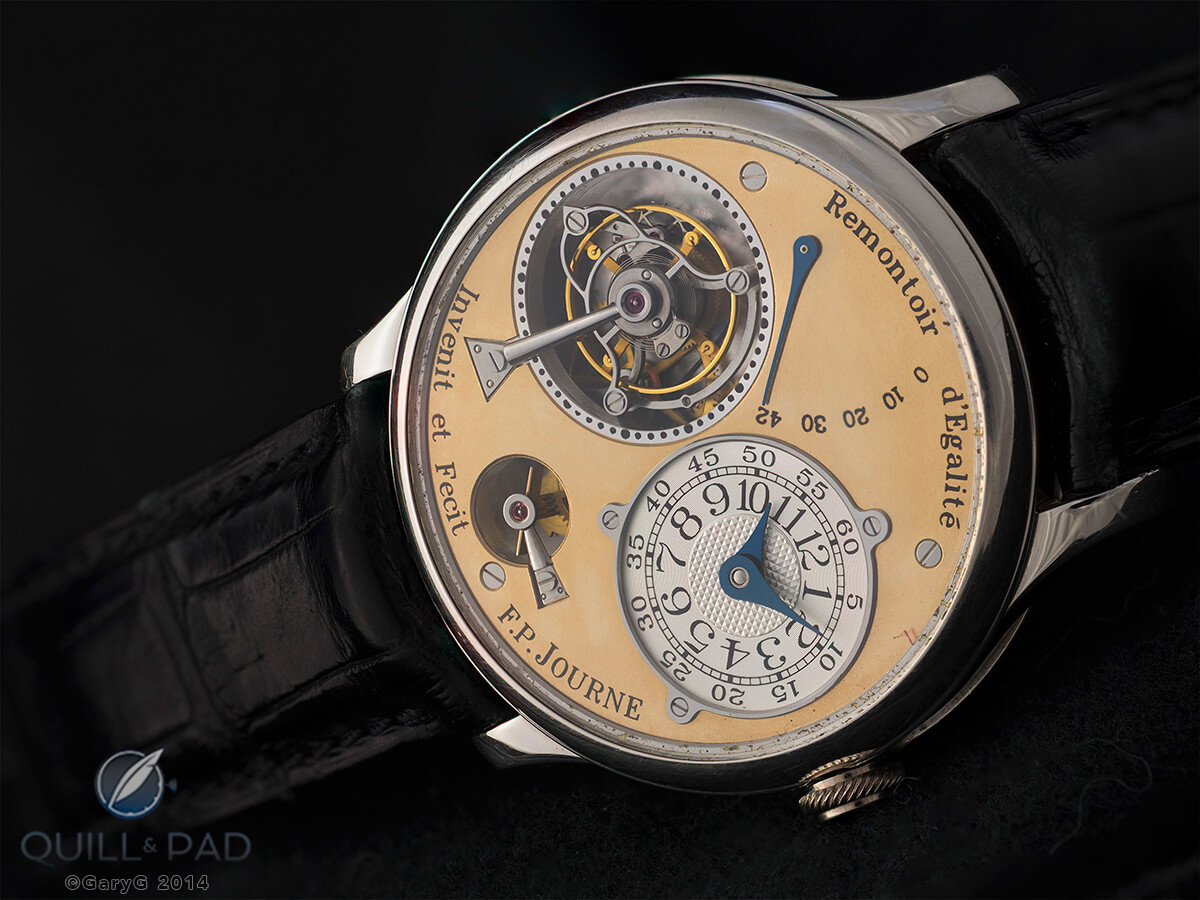
Early model F.P. Journe Tourbillon Souverain with remontoir d’égalité
For more information, please visit fpjourne.com/eu/collections-en-sln-1.html.
Quick Facts F.P. Journe Tourbillon Souverain
Case: platinum or red gold, 38 mm
Movement: manually wound Caliber 1498 with constant force regulated by remontoir d’égalité
Functions: hours, minutes, seconds (on tourbillon cage); power reserve indicator
Price: originally ca. $120,000 in platinum, recent auction sale prices vary between $70,000 and $95,000 (including buyer’s premium)
Production years: 1999 through 2004
Remark: this model was later replaced by the Tourbillon Souverain with remontoir and deadbeat seconds (still in production) powered by Caliber 1403 with 18-karat gold plates and bridges; available in 38 and 40 mm platinum and red gold cases
* This article was first published on May 25, 2014 at Behind The Lens: The F.P. Journe Tourbillon Souverain.
by GaryG
One of the great advantages of belonging to the relatively close-knit community of watch collectors is that one has the opportunity to see a lot of great watches.
Even the small group of enthusiasts that I hang out with on a regular basis collectively owns a significant assortment of some of the greatest watches I know – and as they are generous fellows, I have fairly regular opportunities to see, try on, and photograph some of these fantastic pieces.
That’s great for me because like many watch enthusiasts, I’ve also gone a bit nuts about photography. Specifically, macro photography, which at my relatively modest level of competence provides an opportunity to hunch over a camera and light tent for hours on end, fiddling with camera, lens, and watches, hoping that at least a few of the resulting images will justify the stiff neck and strained eyes.
There is now a payoff, though: from time to time, as part of my “enthusiast collector” role here at Quill & Pad I will be taking a look at watches that strike my fancy, and sharing the visual results with you along with a few observations on photography, the watches themselves, and the collectors who own them.
Let’s get started, shall we? Our subject for this episode: the F.P. Journe Tourbillon Souverain with remontoir d’égalité.

F.P. Journe Tourbillon Souverain with remontoir d’égalité
My photography mentor, the outrageously talented Ming Thein, sets out four elements required for a good image: light, subject, composition, and story.
Regardless of what you think of the lighting and composition of this first shot, I hope that you will agree that the subject is a doozy! The Tourbillon Souverain was the first model sold by Mr. Journe’s eponymous enterprise, F.P Journe. In addition to its technical sophistication, it set the basis for the visual style and design cues that are characteristic of Journe’s watches to this day.

F.P. Journe Tourbillon Souverain with remontoir d’égalité
Many directly noticeable visual elements tell us that this is a Journe watch well before we see his name or read the Invenit et Fecit motto on the dial.
These include the use of silvered subdials with screw-mounted steel frames; the fonts; the ornate appearance of the main subdial with its explicit labeling of hours and minutes, railroad track, and guilloche center; the shapes of the hands and bridges; and even the characteristic crown with its rope edge motif.

F.P. Journe Tourbillon Souverain with remontoir d’égalité
There is an inherent risk to getting into watch photography as a watch enthusiast: mixing the two hobbies puts you at a serious peril of buying watches when you weren’t planning to do so! In this instance, a friend of mine asked whether I would take a few pictures of his Journe tourbillon so that he could post the watch for sale.
I happily took him up on his offer, but then something entirely predictable happened: I could not put this one down. He did (or didn’t, depending on your point of view) help by encouraging me to “feel free to keep it and wear it around for a while.”
Suffice it to say that one thing led to another, and now this piece occupies a place of pride in my own collection. Perhaps I’ll return to this watch here on Quill & Pad at some later time and provide a full review that sets out all of its virtues as I see them.
But for now, I’ll just call your attention to the white gold dial and its beautiful color. These early white gold dials from Journe have a tone I haven’t seen anywhere else – almost a champagne color – that I could stare at for hours and that, for me, is the ideal complement to the crisper appearance of the platinum case.
If this watch is so great, you ask, why in the world was my pal selling his? As it turns out, he had just bought the one shown below.

Early model F.P. Journe Tourbillon Souverain with remontoir d’égalité
Wait a minute – isn’t that the same watch? Well, yes and no! Of course, it is also an early Tourbillon Souverain, in fact, even earlier in the series than mine. The most obvious difference is the yellow gold dial, and not just any yellow, but a striking, deep yellow that is to many an even more appealing hue than my “champagne” dial.
It is a dial greatly prized by Journe collectors. Due to the reflectivity of the dial, it’s very difficult to capture its true essence – but perhaps this next shot will give you a sense.

Early model F.P. Journe Tourbillon Souverain with remontoir d’égalité
Despite the apparent similarity of the two watches, there are also several other subtle differences between them that enthusiasts discuss and debate. Take a look at the side-by-side image below and see how many you can spot.

Two F.P. Journe Tourbillon Souverain models with remontoir d’égalité; the slightly earlier model is at left
I may actually miss one or two myself, but based on both research and personal observation, I’d say that in comparison to my watch, the yellow-dialed one is different in the following ways:
The word “Remontoir” is slightly closer to 12 o’clock. Also, the font of the term “Remontoir d’Egalité” also appears to be very slightly different than that on the white gold-dialed watch. Among other things, if you look very carefully you can see that the apostrophe is curved on my friend’s watch and straight on mine.
- It has a different, smaller font for the power reserve indicator.
- It uses much larger, and somewhat more rustic, dots for the seconds on the ring surrounding the opening for the tourbillon.
- There is a poising hole in the tourbillon cage itself (you can just see it if you look at the spot on the cage just to the left of the 16-second mark on the surrounding ring).
- It has an beveled edge around the remontoir bridge opening (the round hole at 6 o’clock) as opposed to a rounded edge on the same hole on my watch.
- The remontoir cock (that small one-arm bridge at 6 o’clock) has a curved, rather than flat, upper surface.
- The word “Invenit” is positioned slightly toward the outside edge of the dial, but this could just be a byproduct of the hand-printing technique utilized.
- The time (hours/minutes) subdial appears brighter. This may be an optical illusion given the different luminosities of the main dials of the two watches, or may be a function of a coating added to the subdial of my watch during its recent full service, as I haven’t read about this particular color difference in any of my research.
- There are more items on this list than one would expect, I suppose. On later watches in this same series, there were even more changes – small and large – including the thickness of the small blade of the remontoir mechanism at 6 o’clock, the diameter of the screws fixing the dial to the movement, and most importantly, the color and patina of the main dials.

Early model F.P. Journe Tourbillon Souverain with remontoir d’égalité
If you’ve been looking at the photos carefully – and if you’ve gotten this far I am guessing that you have – you have already learned one important fact about watch photography: the macro lens (especially when coupled with a high-resolution camera like my Nikon D800E) is a harsh mistress.
Woe be unto her or him who prior to shooting does not invest the time needed to clean the watch thoroughly, as each speck of dust will look like a boulder and any stray threads seem to take on the size of those ropes they use to tie up ocean liners.
As we look at my buddy’s new pride and joy, we can clearly see that it is in need of a full service – lots of crumbled adhesive inside the crystal around its edge (and even some sort of red thread that has worked its way in there), dirty, spent oils on many of the steel surfaces, pitting on the hands, uneven patina on the main dial, scratches on the case, and so on.
Happily, as my “new” watch shows, Journe does a great job reconditioning watches to near-original form, so I’m looking forward to seeing (and photographing) the yellow-dialed watch once it returns from its trip to Geneva.
So, which one is it for you?

F.P. Journe Tourbillon Souverain with remontoir d’égalité

Early model F.P. Journe Tourbillon Souverain with remontoir d’égalité
For more information, please visit fpjourne.com/eu/collections-en-sln-1.html.
Quick Facts F.P. Journe Tourbillon Souverain
Case: platinum or red gold, 38 mm
Movement: manually wound Caliber 1498 with constant force regulated by remontoir d’égalité
Functions: hours, minutes, seconds (on tourbillon cage); power reserve indicator
Price: originally ca. $120,000 in platinum, recent auction sale prices vary between $70,000 and $95,000 (including buyer’s premium)
Production years: 1999 through 2004
Remark: this model was later replaced by the Tourbillon Souverain with remontoir and deadbeat seconds (still in production) powered by Caliber 1403 with 18-karat gold plates and bridges; available in 38 and 40 mm platinum and red gold cases
* This article was first published on May 25, 2014 at Behind The Lens: The F.P. Journe Tourbillon Souverain.
Only Watch 2019 F.P. Journe Astronomic Blue – A Unique Tourbillon, Repeater and Calendar Prototype for Only Watch 2019
Journe ups the game for Only Watch 2019 with a unique Grande Complication watch - which also happens to be one of the most complex wristwatches ever..
2 hours ago|By Brice Goulard|2 minute read

When it comes to charity auction Only Watch, F.P. Journe is always one of the highlights, not only because of the name but mainly because he usually donates a unique, unprecedented and complex watch. Remember the tantalum/chrome blue dial Tourbillon Souverain of 2015? Or the unique Chronographe Monopoussoir Rattrapante of 2017? Well, for the 2019 edition of Only Watch, the brand has just announced an incredible, totally unique (prototype stage), ultra-complex watch: the F.P. Journe Astronomic Blue.
Visually, no big surprise, as F.P. Journe retains his classic “Only Watch” theme, meaning a tantalum case (a rare metal with a dark grey colour and high density), an orange alligator strap and the signature chrome blue dial (which is also found on the Chonomètre Bleu). Considering the impressive number of complications that are included in this watch, the case is relatively large at 44mm in diameter but still reasonable when it comes to thickness, at 13.75mm. Everything you see here on this F.P. Journe Astronomic Blue is unique and has been developed exclusively for Only Watch 2019 – not only the dial and the case but the entire movement and its multiple indications too.

What is really interesting here is the prototype calibre “1619” encased in this tantalum protective box. And yes, this is clearly Journe’s most complex movement ever, and probably one of the most complex movements recently made by the Swiss industry, with no fewer than 18 complications. Dial-side, the F.P. Journe Astronomic Blue displays the time (including dead-beat seconds), the sidereal time, a second time-zone, a power reserve, a day-night indicator, the moon phases and the sunrise and sunset indications. Not the simplest watch to read, but still impressively well organized. The classic chrome blue background with a guilloché silver dial is always a thing of beauty.

The reverse side of the F.P. Journe Astronomic Blue offers another impressive view. The back of the watch reveals a unique movement, which apparently shares almost nothing with the previous watch manufactured by the brand. Visible are a one-minute tourbillon with “remontoir d’égalité” (constant force device), a double barrel, an annual calendar displayed on the periphery of the movement, an equation of time and some of the minute repeater parts, including the governor. As often with Journe, the chiming mechanism is located dial-side and relies on specific, flat hammers and gongs.

This F.P. Journe Astronomic Blue is probably the precursor to a future grande complication watch that Journe will launch in the coming year or so. This model is a unique piece developed exclusively for Only Watch 2019, with an estimated price of CHF 300,000 – CHF 600,000. Expect to see this watch smash a record at auction.
Only Watch is a biennial fundraiser for research on muscular dystrophy – Association Monégasque Contre les Myopathies (AMM). Organized under the patronage of HSH Albert II de Monaco, the watches of the 8th edition will be auctioned by Christie’s on Saturday 9 November 2019. More details at www.onlywatch.com.
TECHNICAL SPECIFICATIONS – F.P. JOURNE ASTRONOMIC BLUE
Case: 44mm diameter x 13.75mm height - tantalum case - sapphire crystals front and caseback
Dial: blue chrome dial, unique examples developed exclusively for Only Watch, with silver guilloché sub-dials
Indications: Front: hours, minutes and seconds of average time; hours and minutes of sidereal time; sunrise and sunset; moon phases; power reserve
Back: annual calendar and equation of time
Movement: exclusive prototype movement "calibre 1619" in 18k rose gold - hand-wound - double barrel with 42h power reserve - minute repeater - one-minute tourbillon with "remontoir d’égalité" - dead-beat seconds
Strap: orange alligator strap
Reference: ref. AST
unique piece, prototype stage, developed exclusively for Only Watch 2019
F.P. Journe Only Watch
Journe ups the game for Only Watch 2019 with a unique Grande Complication watch - which also happens to be one of the most complex wristwatches ever..
2 hours ago|By Brice Goulard|2 minute read

When it comes to charity auction Only Watch, F.P. Journe is always one of the highlights, not only because of the name but mainly because he usually donates a unique, unprecedented and complex watch. Remember the tantalum/chrome blue dial Tourbillon Souverain of 2015? Or the unique Chronographe Monopoussoir Rattrapante of 2017? Well, for the 2019 edition of Only Watch, the brand has just announced an incredible, totally unique (prototype stage), ultra-complex watch: the F.P. Journe Astronomic Blue.
Visually, no big surprise, as F.P. Journe retains his classic “Only Watch” theme, meaning a tantalum case (a rare metal with a dark grey colour and high density), an orange alligator strap and the signature chrome blue dial (which is also found on the Chonomètre Bleu). Considering the impressive number of complications that are included in this watch, the case is relatively large at 44mm in diameter but still reasonable when it comes to thickness, at 13.75mm. Everything you see here on this F.P. Journe Astronomic Blue is unique and has been developed exclusively for Only Watch 2019 – not only the dial and the case but the entire movement and its multiple indications too.

What is really interesting here is the prototype calibre “1619” encased in this tantalum protective box. And yes, this is clearly Journe’s most complex movement ever, and probably one of the most complex movements recently made by the Swiss industry, with no fewer than 18 complications. Dial-side, the F.P. Journe Astronomic Blue displays the time (including dead-beat seconds), the sidereal time, a second time-zone, a power reserve, a day-night indicator, the moon phases and the sunrise and sunset indications. Not the simplest watch to read, but still impressively well organized. The classic chrome blue background with a guilloché silver dial is always a thing of beauty.

The reverse side of the F.P. Journe Astronomic Blue offers another impressive view. The back of the watch reveals a unique movement, which apparently shares almost nothing with the previous watch manufactured by the brand. Visible are a one-minute tourbillon with “remontoir d’égalité” (constant force device), a double barrel, an annual calendar displayed on the periphery of the movement, an equation of time and some of the minute repeater parts, including the governor. As often with Journe, the chiming mechanism is located dial-side and relies on specific, flat hammers and gongs.

This F.P. Journe Astronomic Blue is probably the precursor to a future grande complication watch that Journe will launch in the coming year or so. This model is a unique piece developed exclusively for Only Watch 2019, with an estimated price of CHF 300,000 – CHF 600,000. Expect to see this watch smash a record at auction.
Only Watch is a biennial fundraiser for research on muscular dystrophy – Association Monégasque Contre les Myopathies (AMM). Organized under the patronage of HSH Albert II de Monaco, the watches of the 8th edition will be auctioned by Christie’s on Saturday 9 November 2019. More details at www.onlywatch.com.
TECHNICAL SPECIFICATIONS – F.P. JOURNE ASTRONOMIC BLUE
Case: 44mm diameter x 13.75mm height - tantalum case - sapphire crystals front and caseback
Dial: blue chrome dial, unique examples developed exclusively for Only Watch, with silver guilloché sub-dials
Indications: Front: hours, minutes and seconds of average time; hours and minutes of sidereal time; sunrise and sunset; moon phases; power reserve
Back: annual calendar and equation of time
Movement: exclusive prototype movement "calibre 1619" in 18k rose gold - hand-wound - double barrel with 42h power reserve - minute repeater - one-minute tourbillon with "remontoir d’égalité" - dead-beat seconds
Strap: orange alligator strap
Reference: ref. AST
unique piece, prototype stage, developed exclusively for Only Watch 2019
F.P. Journe Only Watch
Jeg funderer for tiden på hva som er den optimale dress-klokken (for meg). Både estetisk og teknisk synes jeg FPJ og ALS er de to heteste alternativene. En slik klokke må jeg kunne eie inn "i evigheten" og kanskje til og med la barn arve med tiden. Hvordan tenker dere rundt service og reparasjonsbehov for et merke som FPJ i fremtiden? Vil det være enkelt å få tatt service på en FPJ om 25-30 år?
Jeg funderer for tiden på hva som er den optimale dress-klokken (for meg). Både estetisk og teknisk synes jeg FPJ og ALS er de to heteste alternativene. En slik klokke må jeg kunne eie inn "i evigheten" og kanskje til og med la barn arve med tiden. Hvordan tenker dere rundt service og reparasjonsbehov for et merke som FPJ i fremtiden? Vil det være enkelt å få tatt service på en FPJ om 25-30 år?
Tror ikke det vil være noe problem å få servet en FPJ om 20-30 eller 50 år for den saks skyld. Finnes enda særere manufakturer som er i daglig drift som ble produsert for både 50 og 80 år siden. Bare å ta seg en tur på Patek Philippe museet. Der kan du studerer armbåndsur, lommeur, marine chronometer og bordklokker som er eldre enn min avdøde bestefar.
Tilgjengelig for den kjøpelystne nå:
F.P.Journe Watches | Chrono24.com
F.P.Journe watches in stock now. New offers daily. Save favorite watches & buy your dream watch on Chrono24.com.
chrbir
Støttemedlem
Jeg ble nysgjerrig på hva de mente med at dette skulle være et mysterium det tok 350 år å løse, siden synkronisering av pendler og metronomer er et standard demonstrasjonsforsøk i fysikkundervisning. Det skjer ved at massesenteret for systemet vil stå i ro dersom summen av ytre krefter er null.
Forskjellen mellom disse forsøkene og FPJs Chronomètre à Résonance (og eldre pendeldrevne klokker), er at i det siste tilfellet er det en stiv kobling mellom oscillatorene slik at det er lyd-/trykkbølger som får dem til å vekselvirke og svinge i motfase.
Her er artikkelen det refereres til i videoen, og som forklarer fysikken bak fenomenet:
Huygens synchronization of two pendulum clocks, Henrique M. Oliveira and Luís V. Melo
En oversikt over noen dobbelpendelklokker gjennom tidene:
Double Pendulum Resonance Clocks, John Kirk
MrFinale
Støttemedlem
S
Slettet bruker 2146
Guest
Del:
















